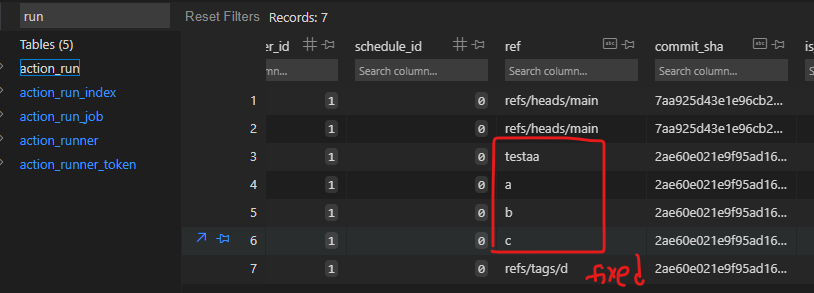When the title of an issue or a pull request is changed, the edited
event must be triggered, in the same way it is when the body of the
description is changed.
The web endpoints and the API endpoints for both pull requests and
issues rely on issue_service.ChangeTitle which calls
notify_service.IssueChangeTitle.
(cherry picked from commit f6000c3760)
Fix #29731
Caused by #24634
Also remove fixme.
ps: we can not fix the existed runs, as wrong refs are all recorded in
DB, and we can not know whether they are branch or tag:

(cherry picked from commit 98217b034076157547cf688cc10f47cd3275c872)
Conflicts:
tests/integration/actions_trigger_test.go
there is a need for more imports because the exist tests
are done differently, using CreateDeclarativeRepo
1. Fix incorrect `HookEventType` for issue-related events in
`IssueChangeAssignee`
2. Add `case "types"` in the `switch` block in `matchPullRequestEvent`
to avoid warning logs
(cherry picked from commit 1ad4bb9eb7641a552c5b88a43eb91d59ec5c0edf)
Fix #29175
Replace #29207
This PR makes some improvements to the `issue_comment` workflow trigger
event.
1. Fix the bug that pull requests cannot trigger `issue_comment`
workflows
2. Previously the `issue_comment` event only supported the `created`
activity type. This PR adds support for the missing `edited` and
`deleted` activity types.
3. Some events (including `issue_comment`, `issues`, etc. ) only trigger
workflows that belong to the workflow file on the default branch. This
PR introduces the `IsDefaultBranchWorkflow` function to check for these
events.
(cherry picked from commit a4fe1cdf38f9a063e44b197ef07e4260f731c919)
Conflicts:
modules/actions/github.go
context
Fix #29166
Add support for the following activity types of `pull_request`
- assigned
- unassigned
- review_requested
- review_request_removed
- milestoned
- demilestoned
(cherry picked from commit 1a6e1cbada27db1e3327b0d7d331492c95e24759)
Fixes #28699
This PR implements the `MigrateRepository` method for `actionsNotifier`
to detect the schedules from the workflow files in the migrated
repository.
This PR replaces all string refName as a type `git.RefName` to make the
code more maintainable.
Fix #15367
Replaces #23070
It also fixed a bug that tags are not sync because `git remote --prune
origin` will not remove local tags if remote removed.
We in fact should use `git fetch --prune --tags origin` but not `git
remote update origin` to do the sync.
Some answer from ChatGPT as ref.
> If the git fetch --prune --tags command is not working as expected,
there could be a few reasons why. Here are a few things to check:
>
>Make sure that you have the latest version of Git installed on your
system. You can check the version by running git --version in your
terminal. If you have an outdated version, try updating Git and see if
that resolves the issue.
>
>Check that your Git repository is properly configured to track the
remote repository's tags. You can check this by running git config
--get-all remote.origin.fetch and verifying that it includes
+refs/tags/*:refs/tags/*. If it does not, you can add it by running git
config --add remote.origin.fetch "+refs/tags/*:refs/tags/*".
>
>Verify that the tags you are trying to prune actually exist on the
remote repository. You can do this by running git ls-remote --tags
origin to list all the tags on the remote repository.
>
>Check if any local tags have been created that match the names of tags
on the remote repository. If so, these local tags may be preventing the
git fetch --prune --tags command from working properly. You can delete
local tags using the git tag -d command.
---------
Co-authored-by: delvh <dev.lh@web.de>
`HookEventType` of pull request review comments should be
`HookEventPullRequestReviewComment` but some event types are
`HookEventPullRequestComment` now.
To avoid duplicated load of the same data in an HTTP request, we can set
a context cache to do that. i.e. Some pages may load a user from a
database with the same id in different areas on the same page. But the
code is hidden in two different deep logic. How should we share the
user? As a result of this PR, now if both entry functions accept
`context.Context` as the first parameter and we just need to refactor
`GetUserByID` to reuse the user from the context cache. Then it will not
be loaded twice on an HTTP request.
But of course, sometimes we would like to reload an object from the
database, that's why `RemoveContextData` is also exposed.
The core context cache is here. It defines a new context
```go
type cacheContext struct {
ctx context.Context
data map[any]map[any]any
lock sync.RWMutex
}
var cacheContextKey = struct{}{}
func WithCacheContext(ctx context.Context) context.Context {
return context.WithValue(ctx, cacheContextKey, &cacheContext{
ctx: ctx,
data: make(map[any]map[any]any),
})
}
```
Then you can use the below 4 methods to read/write/del the data within
the same context.
```go
func GetContextData(ctx context.Context, tp, key any) any
func SetContextData(ctx context.Context, tp, key, value any)
func RemoveContextData(ctx context.Context, tp, key any)
func GetWithContextCache[T any](ctx context.Context, cacheGroupKey string, cacheTargetID any, f func() (T, error)) (T, error)
```
Then let's take a look at how `system.GetString` implement it.
```go
func GetSetting(ctx context.Context, key string) (string, error) {
return cache.GetWithContextCache(ctx, contextCacheKey, key, func() (string, error) {
return cache.GetString(genSettingCacheKey(key), func() (string, error) {
res, err := GetSettingNoCache(ctx, key)
if err != nil {
return "", err
}
return res.SettingValue, nil
})
})
}
```
First, it will check if context data include the setting object with the
key. If not, it will query from the global cache which may be memory or
a Redis cache. If not, it will get the object from the database. In the
end, if the object gets from the global cache or database, it will be
set into the context cache.
An object stored in the context cache will only be destroyed after the
context disappeared.